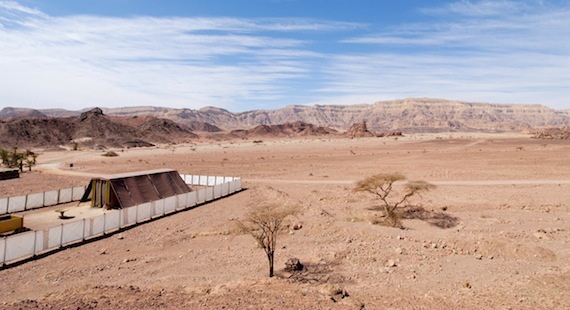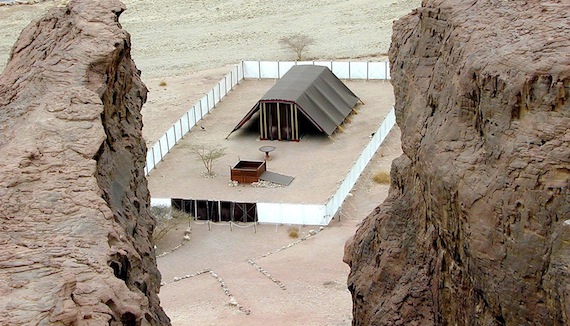The best part of Timna Park is its least-known exhibit. Tucked away among the steep sandstone formations in Israel’s Arabah Valley sits a place most visitors never see.

(Photo: Tabernacle model at Timna Park. Courtesy of the Pictorial Library of Bible Lands.)
Timna Park’s best-known attraction is called “Solomon’s Pillars”—beautiful Nubian sandstone formations that have nothing to do with King Solomon. The park also features relics from Egyptian idolatry as well as interpretive signs about ancient copper mining. But the best part? A full-scale replica of the Tabernacle stands in the very wilderness where Moses and the children of Israel wandered for forty years.
It is like entering a doorway to history—and viewing a picture of your salvation.
Timna Park’s Tabernacle
Reading the Tabernacle’s dimensions in Exodus 35-40 is so different from seeing them with your own eyes—and in the same wilderness where the Tabernacle stood (Exodus 40:34-38).
The realistic replica echoes of Yom Kippur—the Day of Atonement—when God forgave the sins of His people.
The simple white fabric that flapped in the breeze formed the perimeter of the Tabernacle, and it served as the first of a number of barriers between the Hebrews and the Lord.
Barriers for Protection, Implements for Worship
Today we place barriers between our leaders and the people in order to protect the leader. But the Tabernacle’s barriers stood to protect the people from God. No one ever would come into the presence of a holy God without a sacrifice for sin—because holiness cannot abide sin in its presence. What stood before me reminded me of that fact.

(Photo: Tabernacle model from above. Courtesy of the Pictorial Library of Bible Lands.)
- The large, brazen altar was the place where the majority of sacrifices occurred on a daily basis. All sacrifices began with “the burnt offering,” from the Hebrew term olah (Leviticus 1:3). The English word “holocaust” (meaning “burnt whole”) comes from this term.
- Just past the brazen altar stood the bronze laver, the washbowl where the priests would scrub up. Behind it, the tent called “the Holy Place” had dull colors on the outside, but underneath I saw beautiful embroidery of colorful cherubim.
- Entering the Holy Place was something only priests could do, but today, Timna Park visitors can enter to examine the Tabernacle’s interior. After my eyes adjusted to the dark room, I saw on the right the Table of Showbread with its twelve loaves that represented Israel’s twelve tribes.
- The menorah on the left offered meager lighting, and the lack of breeze made the room stifling. The Altar of Incense stood in the back before the small room called “The Holy of Holies.”
The Day of Atonement Illustrated
On Yom Kippur, Aaron the priest would wear humble clothing and offer on the Brazen Altar a bull for himself and for the priests.
Leviticus 16 lays out the instructions.
- Aaron would cast lots to decide which of two goats would be sacrificed and which would be the “scapegoat,” or the “goat of removal.”
- He would take a fire pan of coals from the altar and go inside the Holy Place with incense. As he entered the Holy of Holies, smoke from the incense would shield Aaron from the glory of God.
- He would sprinkle the blood of the bull and one of the goats on and in front of the mercy seat—the top of the Ark of the Covenant. The words “mercy seat” come from a Hebrew word related to kippur—“to make atonement.”
- Aaron then laid his hands on the head of a goat, and confesses over it all the sins of Israel—symbolically transferring the sins from the nation to one goat. And the goat was carried away to a distant desert. The scapegoat ceremony was seen by all and could be understood by all. It was a powerful visual aid that demonstrated the reality of sin and the need to eliminate it through a sacrifice that took your place.
(All pics courtesy of the Pictorial Library of Bible Lands.)
Exploring the replica of the biblical Tabernacle in Timna Park, it is hard to take it all in.
Timna Park is a wonderful place to visit. Not many other parks can offer such great lessons in biblical history, in personal holiness, and in the purpose of Yom Kippur.
That’s a bargain for the price of an admission ticket.
Devotional Thought for Timna Park
Read Romans 3:21-25; Hebrews 9:11-14; 10:19-23.
These rituals on Yom Kippur made the impossible possible. By one man cleansing the sanctuary, a holy God continued to dwell among an unholy people. Today, the Jewish people have no Temple, so they just pray for atonement.
When we come to the New Testament you see what you saw in the Old: there is but one mediator between God and man who offers the blood of a substitute who died for you.
When we purchase something with a credit card, what have we actually spent? Nothing. We’re buying on credit. We don’t actually pay for it until the bill comes in. But we do get to enjoy the benefit of our purchase immediately. In the same way, in the patience of God, He “passed over” previous sins (Romans 3:25). This means that all the elaborate rituals done on Yom Kippur didn’t pay for sin. It only delayed the payment, but they got to enjoy the benefits of forgiveness as if their sin was paid for. The bill for all the sins came due when Jesus’ death on the cross paid for all sins of all time.
When Jesus died, the veil in the temple was torn in two from top to bottom. The veil that separated God from man was removed by Jesus’ death. The first Good Friday was the last Yom Kippur. Any may come to God by faith in the Messiah Jesus.
The author of Hebrews makes this clear:
Since therefore, brethren, we have confidence to enter the holy place by the blood of Jesus, by a new and living way which He inaugurated for us through the veil, that is, His flesh, and since we have a great priest over the house of God, let us draw near with a sincere heart in full assurance of faith, having our hearts sprinkled clean from an evil conscience and our bodies washed with pure water. Let us hold fast the confession of our hope without wavering, for He who promised is faithful. —Hebrews 10:19-23
We may have hearts sprinkled clean, and while we rejoice in our freedom from sin, we never should forget our debt to God.
Tell me what you think: What part of the Tabernacle most helps you consider your redemption? To leave a comment, just click here.
